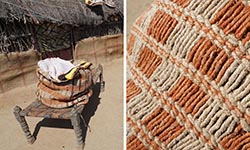
Advocacy, Case Studies, Craftspersons/ Artisanal, Entrepreneurship, Business Devt.
Akara – Fibre of the Desert
Meena, Madan
Issue 10,Summer 2023
Issue #10, 2023 ISSN: 2581- 9410
By the end of the Pleistocene period (roughly 2.5 million years ago to 10,000 BC) historical references state that some of our ancestors had started using various kinds of traps, nets and snares for hunting.[1] These could have been of leather, hair, roots or natural fibres. This was also the period when man started settling down to practice agriculture. During this period, humans started using grass and wood to make their shelters in the form of tents or huts, particularly in the tropics and subtropics. Different kinds of fibres may have been discovered during this period.
Flex, linen and hemp are believed to be the earliest cellulose plant fibres used for spinning and weaving for production of textiles and have been found across various excavated historical sites in India, China and Egypt. These were followed by cotton and silk (4500 BC to 2640 BC).[2] In Europe, the Swiss Lake Dwellers cultivated flax and wove linen into fabrics as early as 8000 BC.[3] These facts ascertain that people had the skill to extract fibre from plants at the very beginning of settled life. Apart from textiles, man used various fibres available from the local vegetation for agricultural use, housing, transportation and hunting. The wandering tribes moving across the forests and deserts also relied on material available in their immediate environ...
This is a preview. To access all the essays on the Global InCH Journal a modest subscription cost is being levied to cover costs of hosting, editing, peer reviewing etc. To subscribe, Click Here.
ALSO SEE
Framing the Fluid Multiple Perspectives on Bhar...
Johar, Navtej
Sustaining Crafts and Livelihoods
Wood, Sharmila


